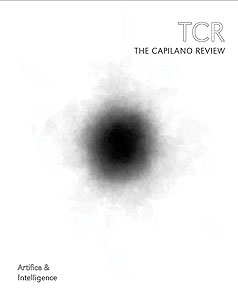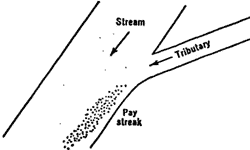Over the course of the six months that I was posting to Tributaries & Text-Fed Streams I had the occasion to explain the project many times to many people, often with little or no success. Some said: Wow, that sounds so cool… But I know they’d never read a word of it. Others smiled and nodded even as their eyes literally glazed over. Only a brave few admitted they had no idea what I was talking about. You few, you are true friends.
None of this bothered me of course. I knew that this exploration of the formal, functional and poetic properties of RSS would be best understood in its natural element (online) and would be most closely read by an online community already habituated to navigating the tributaries of text-fed streams.
So why, from day one, did I insist that the commissioning body, The Capilano Review, go to the trouble and expense to fly me from Montreal to Vancouver for a real-time one-time only launch event?
The more open-ended, circuitous and recursive a project sets out to be, the more necessary closure becomes. I posted the last fragment of text from the “original” source two days before the Vancouver launch. Had not had a plane to catch and a mic to get in front of I could have continued frigging around with the texts of TCR 2-50 indefinitely.
Tributaries curator Kate Armstrong supported the idea of a Vancouver launch event from day one. While she was researching potential launch event venues she sent me this email:
HI JR
Do you by any wild chance know Billy Mavreas?BILLY MAVREAS is a Greek-Canadian artist and cartoonist living in Montreal. His artwork has been shown internationally. He is the author of The Overlords of Glee (2001) and the upcoming Inside Out Overlap (Timeless Books, 2008), and also the proprietor of his enduring project, Monastiraki, a Mile-End magickal curiosity shoppe and art gallery.
I replied:
> Yeah, he’s my neighbour and dear friend and we were at Banff together
> and so on. Why do you ask? He’s having a show at Helen Pitt around
> the same time I’ll be in Vancouver.
The rest, as they say, took a few more weeks to plan. But in the end, yes, we had the launch event at the Helen Pitt Gallery, where my friend and Montreal neighbour Billy Mavreas was artist in residence and the director Lance Blomgren had just agreed to contribute texts to another electronic literature project I’m working on and all three of us are Conundrum Press authors. Thank you Lance and Billy for letting us take over the Helen Pitt for the evening. Special thanks Billy for physically remixing a print copy of TCR 2-50 and handing out the mini-zine results on the spot, and for making such Tributaries-looking wall art for us to all stand in front of. And extra special thanks Emilie for pouring wine all evening and without whom I might not have made it to the gallery at all that day, but that’s another story.
Many dear friends showed up for the event, including some long-lost ones and some never before met in person ones and some in the “I have no idea what this project’s about” category. The pressure was on!
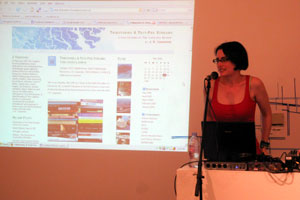
The Tributaries & Text-Fed Streams project is nowhere near as complicated as it sounds. It’s about reading. I held up my copy of TCR 2-50 for the audience to see all the underlined passages, circled sections, arrows, stars and annotations scribbled in the margins. We all do this when we read, don’t we? We interpret, interrupt, form metal images, take notes, and make associations. As I parsed and posted fragments of the essays of TCR 2-50 I marked them up, into JRML, as Kate Armstrong once quipped.
There are hundreds of different ways to read Tributaries & Text-Fed Streams. One good place to start is with the post: What the Heck is RSS?
A good example of JRML is section of Sandra Seekins’ essay dealing with the metaphors and media of biotechnologies which led to me to quote a sequence of pre-genetic-technology references made in literature and philosophy to “metaphors” of bodies as “composites of replaceable parts” in this excerpt: Metaphors of Biotechnology
An intertextual dialogue between TCR 2-50 authors emerges in the matrix/chora section of Kevin Magee’s poem To Write as Speach.
After showing these ways of reading Tributaries I went behind the scenes to show how the piece actually works. I posted an image to Flickr, commented on it, tagged it and then it appeared on the Tributaries main page through the magic of a Flickr RSS feed. I saved a bookmark to del.icio.us and that too was pulled into the Tributaries interface. I posted a new post to Tributaries: Alternate Readings: The In This Issue Remix, then logged into Facebook as Babble Brook (a character created to aid and abet with the Tributaries project). RSS had already pulled the afore mentioned Flickr image, del.icio.us bookmark and Tributaries post into Babble Brook’s profile and pushed news of them out into the feeds of all her friends. Having fed all that info into the text-fed stream, Babble Brook and I got off the mic and let the experts take over.
In a stroke of pure genius Tributaries curator Kate Armstrong invited three experts on streams to perform at the launch event: Dr. Michael Boyce, expert in stream of consciousness; Dr. Maria Lantin, Director of the Intersections Digital Studios, a research space at Emily Carr and thus an expert in data flow; and Dr. Jeremy Venditti, an expert in river geomorphology, turbulence and sediment transport dynamics in gravel-bedded streams. Now Dr. Boyce I’ve known for fifteen years, but Dr. Lantin and Dr. Venditti I’d never met before. This triumvirate of stream experts gave a brilliantly intermingled reading that riffed on the theme of streams. For example, if anyone is still wondering why on earth one would feed the texts of a print journal into a RSS stream, consider the transformational effects of the stream as outlined in this passage quoted by Dr. Venditti:
The Stream – Along the bottom of every gorge is a stream channel. In it may flow a great river or a brook or only a temporary torrent. The stream is there because the slopes of the land guide the water that way, and the stream may thus be said to exist on account of the channel. But in an equally important way the gorge exists because of the stream, for the stream is in fact the maker of the gorge and is still at work on it, deepening and enlarging. Let us look at the stream…
Grove Karl Gilbert and Albert Perry Brigham, An Introduction to Pyhsical Geography, 1902.
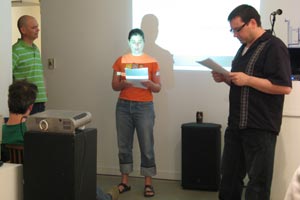
For me – standing in the audience having only just emerged seconds before from six intense months of working on Tributaries & Text-Fed Streams – this intertextual interdisciplinary reading of the work was a gift, and a joy to witness. Thank-you Michael, Maria and Jeremy for your generosity and thank-you Kate from coming up with this idea.
Meanwhile, on the other side of the gallery, throughout the evening TCR 2-50 guest editor and contributor Andrew Klobucar had been feeding portions of the readings into the Global Telelanguage Resources Workbench, which is basically a definition-generating machine. Despite having marked up an essay about this tool in Tributaries, it wasn’t until Andrew read performed the definitions generated in response to the evening’s other performances that I understood how innately hilarious the Global Telelanguage Resources project is! Thank you Andrew!
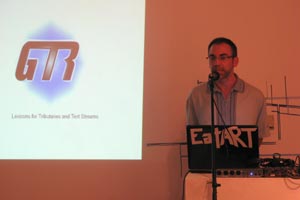
The performances were followed by a set from DJ Leigh Christie, who had already rocked my world earlier in the day during the tech set up. Even when the internet connection conked out, even when the data projector insisted on projecting upside-down, DJ Leigh kept our spirits running high. Thank you Leigh!

The longer you work on a project the more likely a launch event is to feel anti-climatic, especially an entirely web-based project. In this case, this was not the case. I’m grateful to The Capilano Review for seeing the project through to this conclusion. I was blown away by the turn out for the event, by the emotions of reuniting with long lost friends, by the generosity of all of the contributors and performers and by the responses to the work that the event generated.
Here’s how I know the event was a success: all the people who had told me beforehand that they didn’t get what this work was about came up to me after and said that now they get it. That’s about as climatic as you can get.
. . . . .

